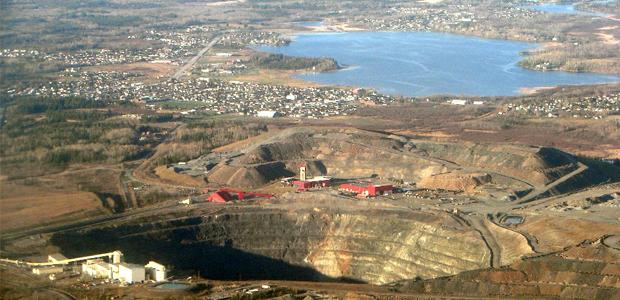Researchers from Canada and the United Kingdom have found that water pouring into of a mine could be as much as 2.6 billion years old and may even support life.
An Ontario mine has stumbled on more than the copper and zinc that’s deposited 2.4 kilometres deep inside the Canadian Shield – that’s roughly 40 NHL rinks deep if you stacked them end-to-end.
Buried alongside some of the world’s oldest rocks, a team of researchers from Canada and the United Kingdom said the miners tapped into some of the world’s oldest water and an analysis of its isotope fingerprint shows that it may have been marinating there, for as much as 2.6 billion years.
“When the water and rock sit in contact with each other, over a long time period, the waters leach the chemistry out of the rock,” Barbara Sherwood Lollar, study co-author and geochemist at the University of Toronto, told SciFare.com. “You end up with a very saline, energy rich water.”
With a minimum residence time of 1.5 billion years – that’s the technical term for the time that’s elapsed since it was first deposited – that chemistry has also given it a musty smell and made it much more dense than water as we know it.
“The very high salt content of these rocks and the chemistry, in many ways, is similar to the kinds of fluids one sees at the hydrothermal vents,” Sherwood Lollar said.
The researchers also found methane and hydrogen gas dissolved in the water – bubbles in your pop are made by dissolving carbon dioxide in it – meaning the essential building blocks required to support life, one and a half miles deep in the Earth’s crust, are also present there.
“It contains the kinds of chemistry that provide energy for subsurface microbial life,” she said.
The first chemical eating creatures – scientists call these chemoautotrophic organisms – were actually discovered near hydrothermal vents and at another mine in South Africa, Sherwood Lollar and her team have dated water that’s roughly 10 million years old, only to learn that it too, is teeming with creatures.
“When we find waters of a similar kind of chemistry and energy, elsewhere, these waters are called habitable – meaning they have the potential to harbour life,” Sherwood Lollar said.
Now that they know it can harbour life, the question shifts to finding out if it’s actually there. If there’s life deep in the Earth’s crust, it would give researchers a unique window into an environment that may have been evolving on its own, for at least 1.5 billion years – sort of like the Galapagos of the deep crust.
It could even raise the possibility of finding life on Mars.
“Major components of Mars’ crust, is made up of rocks of the same age and some have the same mineralogy,” Sherwood Lollar said. “If we can find waters that are still rich in the chemistry that can support life, deep within these billion year old rocks on Earth, it seems likely that we might be able to find a similar phenomenon there.”
Reports about water deep in the Earth’s crust aren’t new, but they’ve certainly flown under the radar of science, Sherwood Lollar said – some of the earliest reports of salty water like this in Canada, date back more than 125 years.
“We’ve known that there are saline waters there now for 20 years, but this this the first time that we have any sense of the extreme antiquity of these waters,” Sherwood Lollar said.
Chris Ballentine is another of the study’s co-authors and said it was traces of noble gases that have either accumulated, or had their signatures preserved in the water that allowed them to date it – it was also his post-doc, Greg Holland, who led this study. He’s now at Lancaster University.
The simplest is essentially a variation of the famous radiocarbon technique. Uranium that’s naturally present in the rock decays, like carbon-14 does, to a radioactive isotope of helium.
“That helium-4 goes into the water phase and builds up with time,” Ballentine, who’s also a professor of geochemistry at the University of Manchester, told SciFare.com. “Just the raw amount of helium in the water allows us to place an age on it.”
The researchers also measured radioactive neon and argon signatures using the same method.
The second technique analyzes the profile of xenon’s isotopes. French-led researchers have found that the ratio of this noble gas has changed through time and that early records of its fingerprint are preserved in barite crystals hiding in the Precambrian rocks.
“We can match that xenon isotopic composition to an ancient signature, which has changed through time and develop an idea of when in time our signature was formed in the atmosphere,” Ballentine said.
The last technique looks at a single isotope of xenon.
“A little bit of radioactive iodine is produced, continuously, by high energy cosmic rays striking gases in the atmosphere,” Ballentine said. “That iodine is very effectively concentrated up in organic rich sediments and it’s a sequence of organic rich and volcanic sediments that formed the rocks we’re looking at.”
After the iodine is deposited, it takes about 100 million years to completely break down into xenon-129 and then, like the rest of the radioactive elements, it accumulates in the water.
“If the water had come and gone, it would have carried out any of that iodine with it,” Ballentine said. “What we see is a really distinct spike of xenon-129 in the water.”
That means some of the water was deposited around the same time as the world’s oldest rocks, roughly 2.7 billion years ago.
“It’s possible that we’ve had an addition of fluid to a really ancient fluid and we’re looking at a mixture,” Ballentine said.
Like the question of life, the researchers are also dating waters from a variety of depths, in order to help understand how many reservoirs might be leaking into the mine.
The research was published in the journal, Nature.
 Science Fare Media Science News – Upgraded
Science Fare Media Science News – Upgraded






